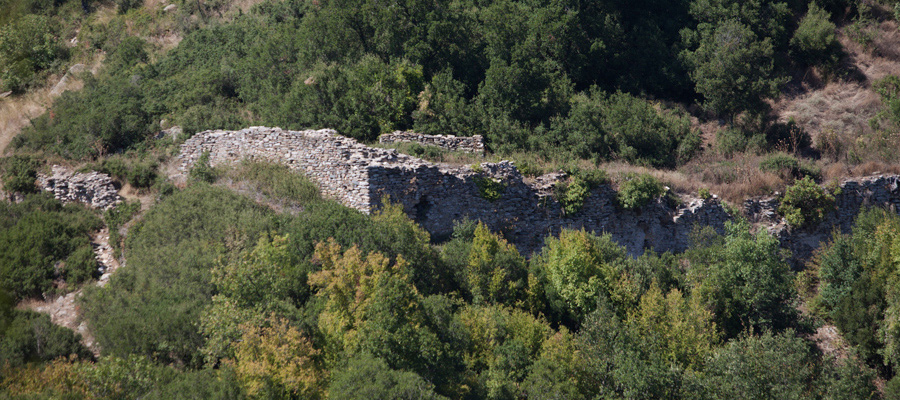Southwest of the settlement of Palaiochori, at the top of a steep hill in the wider area known as Neposi, lies the Castle. The hill is surrounded by the waters of the stream Paliochorinos Lakos, a tributary of the Chavrias River, the river of Ormylia. There is only a narrow and difficult path that connects the inaccessible hill to the mountain extending to the east of it. However, the castle is not easily visible from a distance, as higher mountain masses rise around it, the natural relief is particularly intense, and the vegetation is dense.
Most of the information about the Castle comes from the 10th Ephorate of Byzantine Antiquities of Halkidiki, which conducted excavations here in 1998 and 2003, under the supervision of the archaeologist Ioakeim Ath. Papangelou. The investigations revealed that the defensive wall of about one kilometer, made of rough (uncut) stones and lime mortar surrounding the castle and preserved up to a height of 4 meters, likely includes three construction phases: one during the Paleochristian period, which was probably destroyed by an earthquake, one during the Middle Byzantine period, and probably a third, repair phase.
The castle occupies an area of about 15 acres, and inside it, in the western section, there was a settlement. There was also a wooden-roofed church from the 6th century, in the style of a three-aisled basilica, with a marble chancel screen and a vaulted underground tomb of two beds under the narthex. Many tombs from the Middle Byzantine period were found both inside and around the church. The church was probably destroyed by an earthquake, but later—perhaps in the 10th century—it was restored. Partial excavation also showed that until its final abandonment, it was repaired two more times.
The archaeological investigations provided valuable information about the monument and the area. The handmade pottery shards (ceramic fragments) discovered indicate settlement in the area from prehistoric times. However, the finds are not limited to prehistoric shards. The Hellenistic pottery shards and Roman coins found suggest that the area was inhabited during both the Hellenistic period and the Roman era.
The archaeological excavations also revealed coins of Emperor Anastasius and Justinian, from which it is inferred that the area continued to be inhabited during the 5th and 6th centuries. Finally, glazed ceramic fragments were found, a technique that documents human settlement in the area during the 14th century. It was probably then that the castle was destroyed and abandoned, an event possibly related to the founding of the settlement of Palaiochori, which begins to appear in historical sources around that time. Ioakeim Papangelou also informs us about the two inscriptions found in the ruins of the church. The first is from the 6th century and likely comes from the vaulted underground tomb of the narthex, reading as follows:
+Mnīmíon Ēou- ánnou hyioῦ Eŭ- tropíou, eí tis dè eurethî tí- thon pará gnó- seos emoû, dósi lógon toû Th(eo)û en hēmér(ā) kríseos+
The inscription mentions someone named Ioannis, who was buried in this location, and it is probably poorly written and misspelled. However, from a bronze ring found there, characteristic of the Middle Byzantine period, it appears that the tomb was reused during that period. From the second inscription, which is more important, the right half has survived. It probably relates to the repair of the castle during the Middle Byzantine period and reads as follows:
[… theó]fylakton kástro[n [… pané]ytukhoûs [… Kōnstantín]ou kaì Zōēs […] Mikhaēl patrí[kíu…] toútous to[ς] [… étous] ´SYK[S´]
The year ´SYK[S´] is 917/918, the period of the co-reign of Constantine VII Porphyrogennetos, who was a minor, with his mother Zoe Karvonopsina. The name Michael probably refers to a well-known patrician who lived at that time and may have been involved in the administration of the area or in the repair of the castle. The interest of the nobility in the castle indicates its importance to the region. It likely served as an important link in the defensive network of the empire, as it is known that Halkidiki, especially during the second half of the 10th century, became a target of Bulgarian raids.
DISCOVERING THE WALLS
The approach to the wall and the castle is via a dirt road and an unmarked walking path. Following the main road that connects Palaiochori with Megali Panagia, you will see signs for the wider area known as Neposi less than 3 kilometers to your left. The initially uphill dirt road is passable, and after about 450 meters, you will encounter a new burgundy sign indicating to follow the left branch of the dirt road. Continue, and in less than 3 kilometers, you will reach a wooden observation tower on your left. Climb the small ladder, and you will see most of the stone wall of the castle ahead. To get closer to it, you will need to find an unmarked path a few meters further down, which first descends into the ravine and then ascends towards the Castle.
THE ARTICLE



